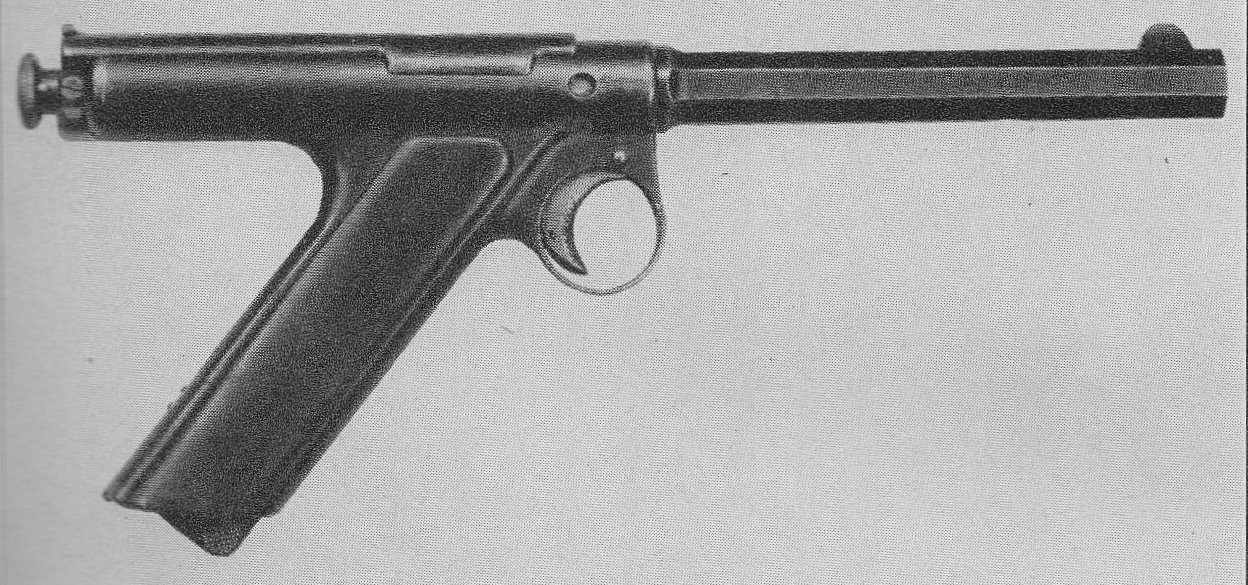
Retrieved: 12/06/2013
Sir Hiram Maxim is famous for his machine guns, but he patented a blowback pistol and built a handful of prototypes chambered in various calibers, including 7.63 Mauser and .455 Webley.
Besides being racy looking, the gun looks very simple. Unfortunately, the "only a few parts" shown in the picture don't show the trigger group. You'll notice there's very little room for naughty bits there...
The number and date of the patent are listed, but my Google-fu can't turn up the patent even though British patents are supposed to be online considerably earlier than 1896. I was hoping a patent drawing would show the FCG.
This is everything I have on the 1896 Maxim:

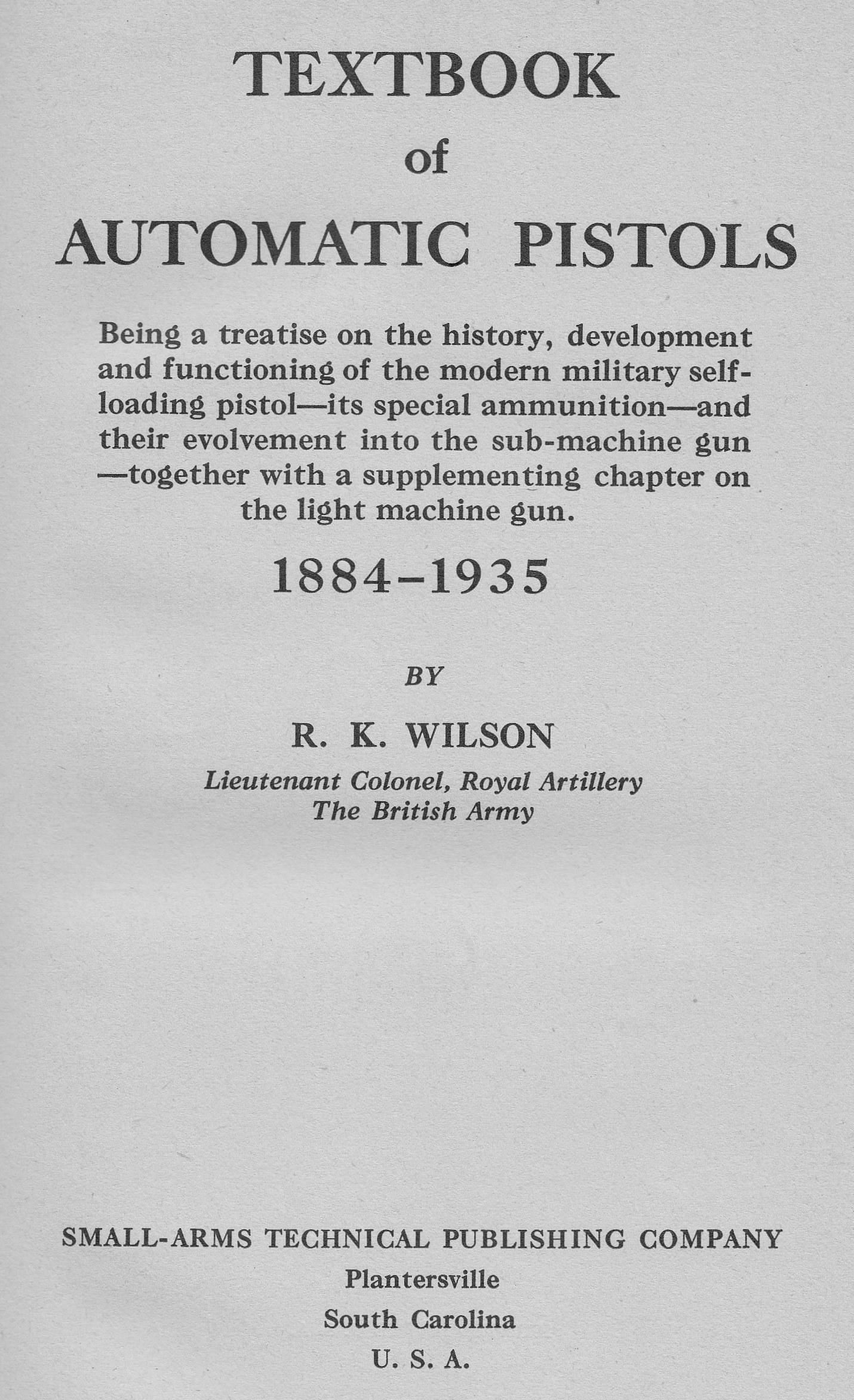
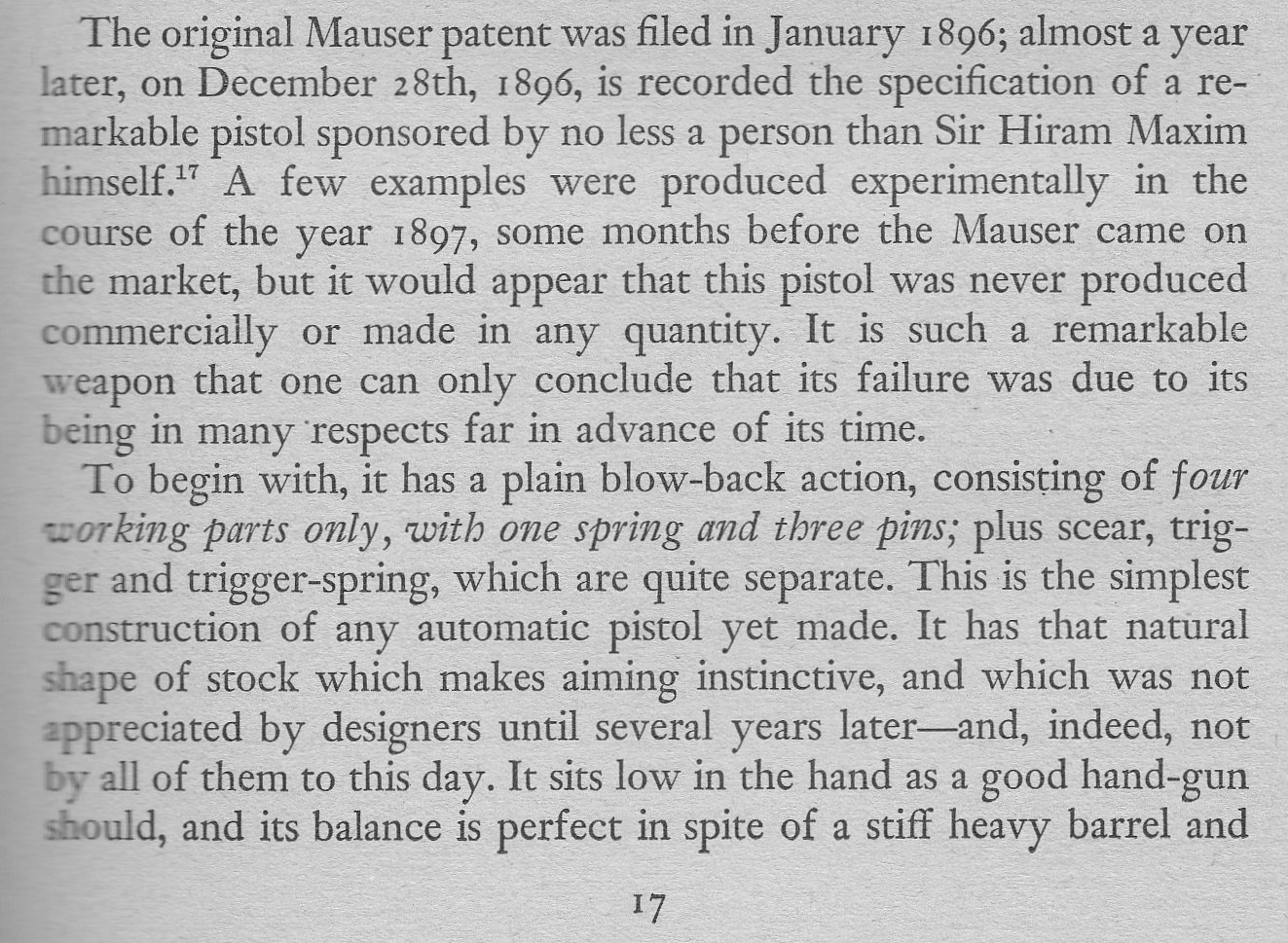


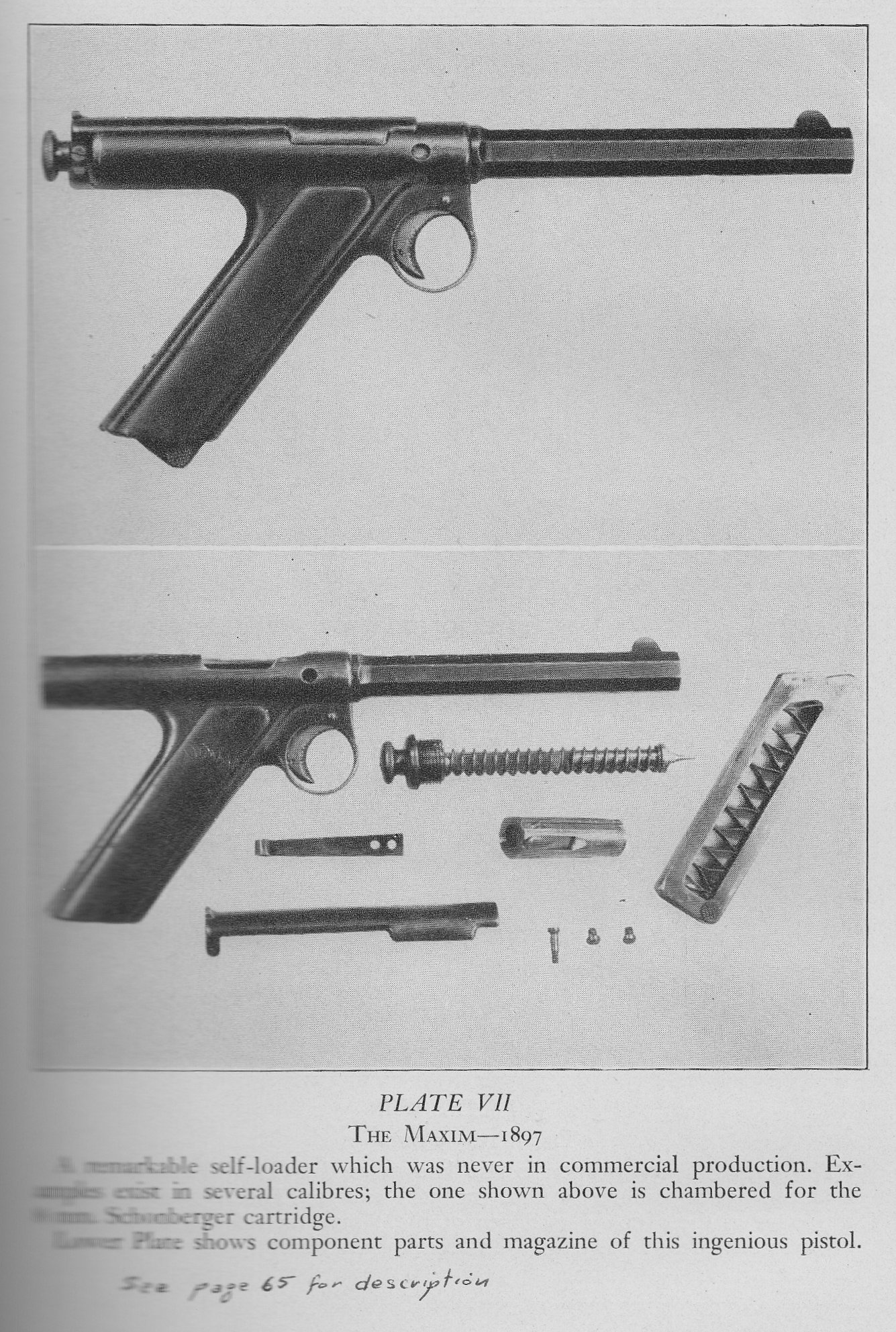

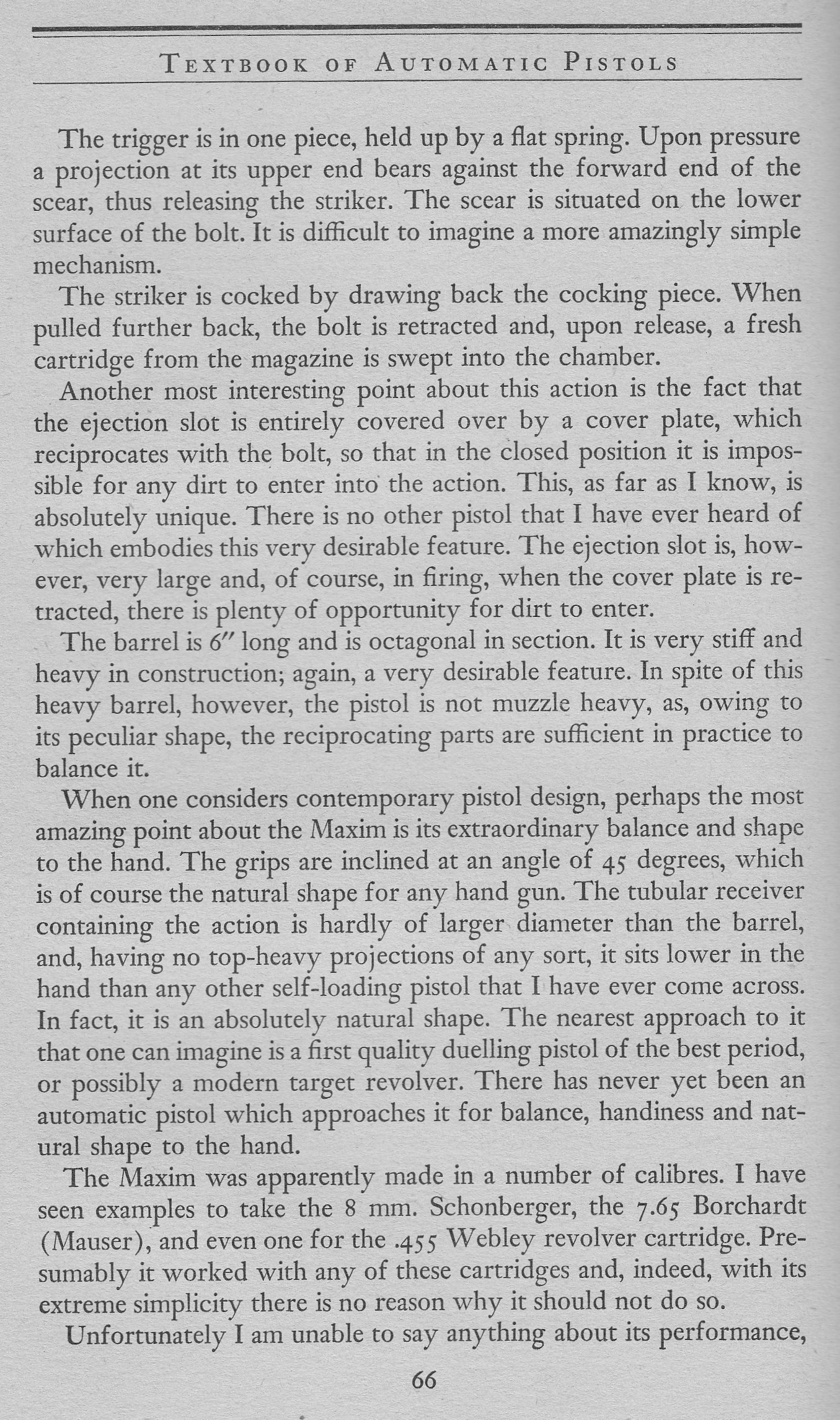

It looks like the striker's inertia cocks the bolt when the bolt hits the screwed-in end cap. The flat spring screws to the bottom the the bolt and holds the sear rocker in the up position, so when the sear comes back forward it's stopped by the rocker.
I still don't know how Hiram Maxim designed his fire control group - as described in the book, it would be an SMG - but I came up with a short pushrod hinged to the trigger, with a spring pushing it toward the back of the gun. A cross pin lines the pushrod up with the front of the rocker, so when the trigger is pulled, the rocker is pushed up.
The trick here is that when the bolt comes back forward, the sear simply pushes the connector pushrod forward if the trigger is still held back. You have to release the trigger for the connector to slide back under the sear.
I'll make a picture and post it later. My little hack ought to work in various tube gun configurations too.
The "ejection port cover" has a retainer screw visible. It looks like it's attached to the striker. It might be to increase the striker mass to ensure setting the striker on recoil, or it might actually be attached to a necked- down portion of the bolt. I need to stare at the picture a while longer. Well, it was reasonably high resolution for 1935...
Looking at the picture, it seems that the top of the receiver is slotted and the ejection cover rides through the slot. This would add more mass to the bolt, and keep the bolt from rotating in the receiver. That's if I'm not
imaginging things. The 8mm Schonberger was, best as I can tell, somewhere around .38 ACP ballistically. I keep thinking I've seen some information on it somewhere. It was considered a hot cartridge in its day.
Google didn't turn up anything about Maxim pistols, but searching on Schonberger came up with a Google Books hit of Ian Hogg's "Pistols of the World" with a couple of paragraphs about the Maxim. Unfortunately most of the entry was excerpted directly from the book above, with an additional note that the British military "might" have declined to consider the Maxim because it "might" have had failures to feed due to the 45 degree grip angle.
That's possible... the bolt doesn't show any mag lip cuts, so the cartridges would have been stripped by a small segment of the bolt, and possibly the forward edge of the sear, if it hung below the bolt body. Though the chamber entry is well forward the approach angle wouldn't have been all that steep... but a quick look says that the cartridge was likely completely uncontrolled between the time the back of the case left the feed lips and the front entered the chamber. Hmm... if that was true the chamber could be moved back a bit, and the magazine sunk into the bolt a bit, and a longer cartridge would help. Just speculation, anyway.
I *think* I see a notch that could be an extractor on the bolt, right on top. Unfortunately, it would be under the front edge of the breech cover, so if it's really an extractor, I'm not sure how it would work. I don't see any ejector either. On the other hand, some blowback automatics didn't use extractors or ejectors back in those days.
I'm wondering about the sliding top cover now. It's that lockscrew that puzzles me. It looks like the cover would be clamped to the striker; the bolt is short and forward. The cover looks like it might be machined steel, but it could be a lightweight stamping for all I know.
I'm figuring the striker is inertially cocked; that is, it continues on back when the bolt stops, then comes back up against the sear as the bolt moves forward. So the bolt cover would stay over the bolt until the bolt stopped. Since the gun ejects upward, it looks like the fired case would simply bounce off the cover before the striker and cover moved back far enough to clear the port. Also, if the cover is only attached at the tail end, it looks like a good way to get a bent cover. But it can't be attached to the bolt (or receiver) if it is connected to the striker, unless there's some kind of dovetail I can't see in the picture.
Hmm...
Here's my take on a fire control group. The trigger hinges from the forward end like the Maxim, and uses a "connector" pushrod that's spring-loaded against the sear, which is pivoted in the bolt. When fired, the bolt returns and pushes the connector forward. It can't fire again until you release the trigger and let the pushrod slip back under the sear.
The stop pin is just a crosspin to keep the connector from going over-center.
I have no idea how Maxim did his, but this one fits his trigger and sear arrangement. His would work with just a nub on the back of the trigger to lift the sear, but it would be fully automatic.

The Maxim has no safety, as far as I can tell. Here are two options for disconnecting the connector. Simplest is to make the stop pin a cam, and add a lever to it. When flipped, the lever would hold the connector forward so it couldn't reach the sear. Alternatively, you could use a stepped cross-pin instead of a cam. Disadvantage: any safety behind the trigger would be hard to reach.
As an option, we could use a wire to pull the connector forward off the stop pin. We could then put a lever, a slider, or a crossbolt ahead of the trigger, where it would be easily reached.
Third is a "trigger safety" design. The connector sits on a carriage hinged off the trigger pin. The trigger has a bump on the back. A weak springs keeps the connector pushed forward. When the trigger is pulled, the bump pushes the sear vertical before the trigger lifts the connector up. I'm kind of proud of that one.
You could probably figure a firing pin safety like many of the modern striker-fired designs. There's room for a separate spring-loaded firing pin; there's as much room ahead of the striker as there is on some falling block rifles.

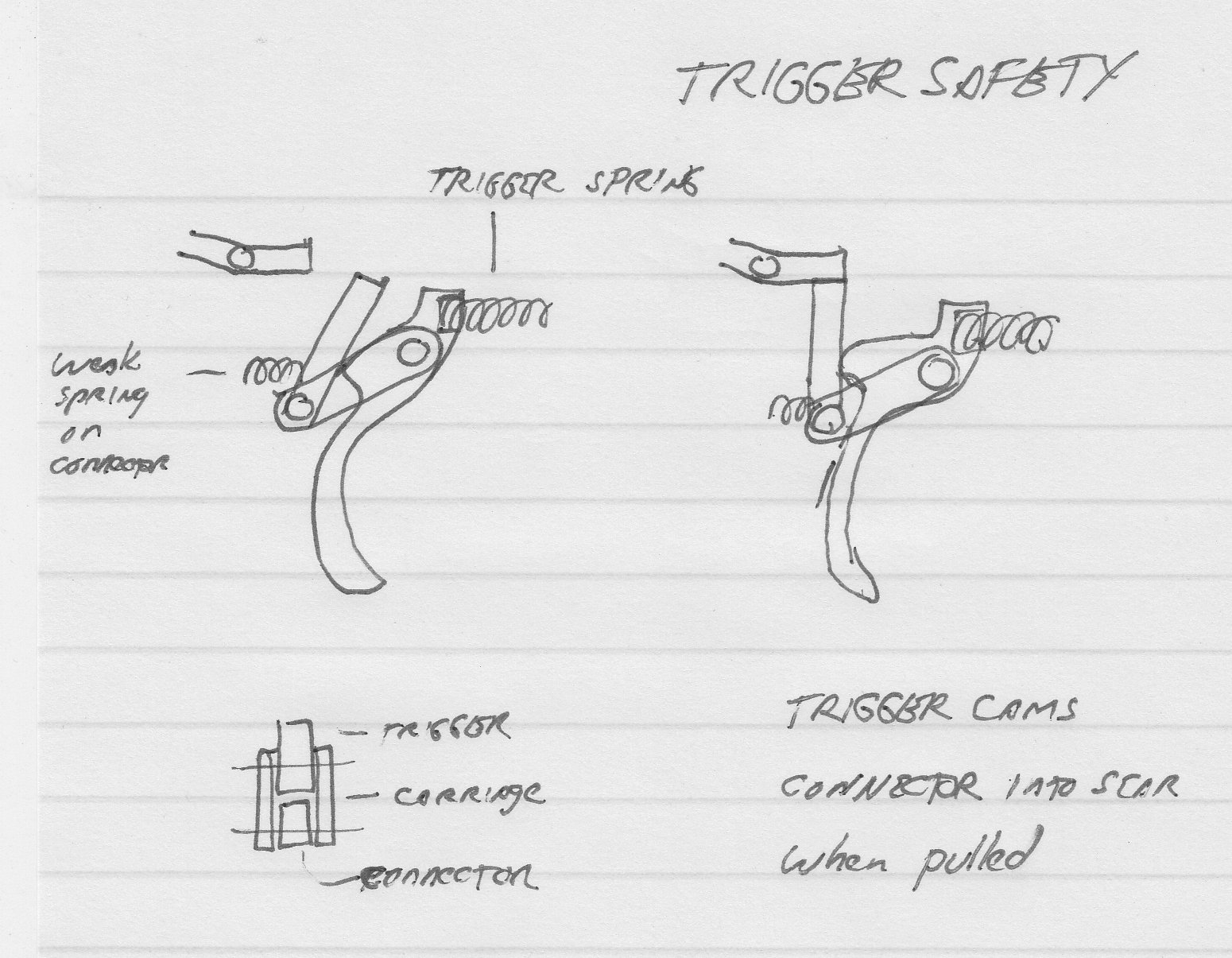
This shows a spring-loaded firing pin ahead of the striker. It also shows a conventional extractor design, just a milled slot, crosspin, and rocker type extractor.
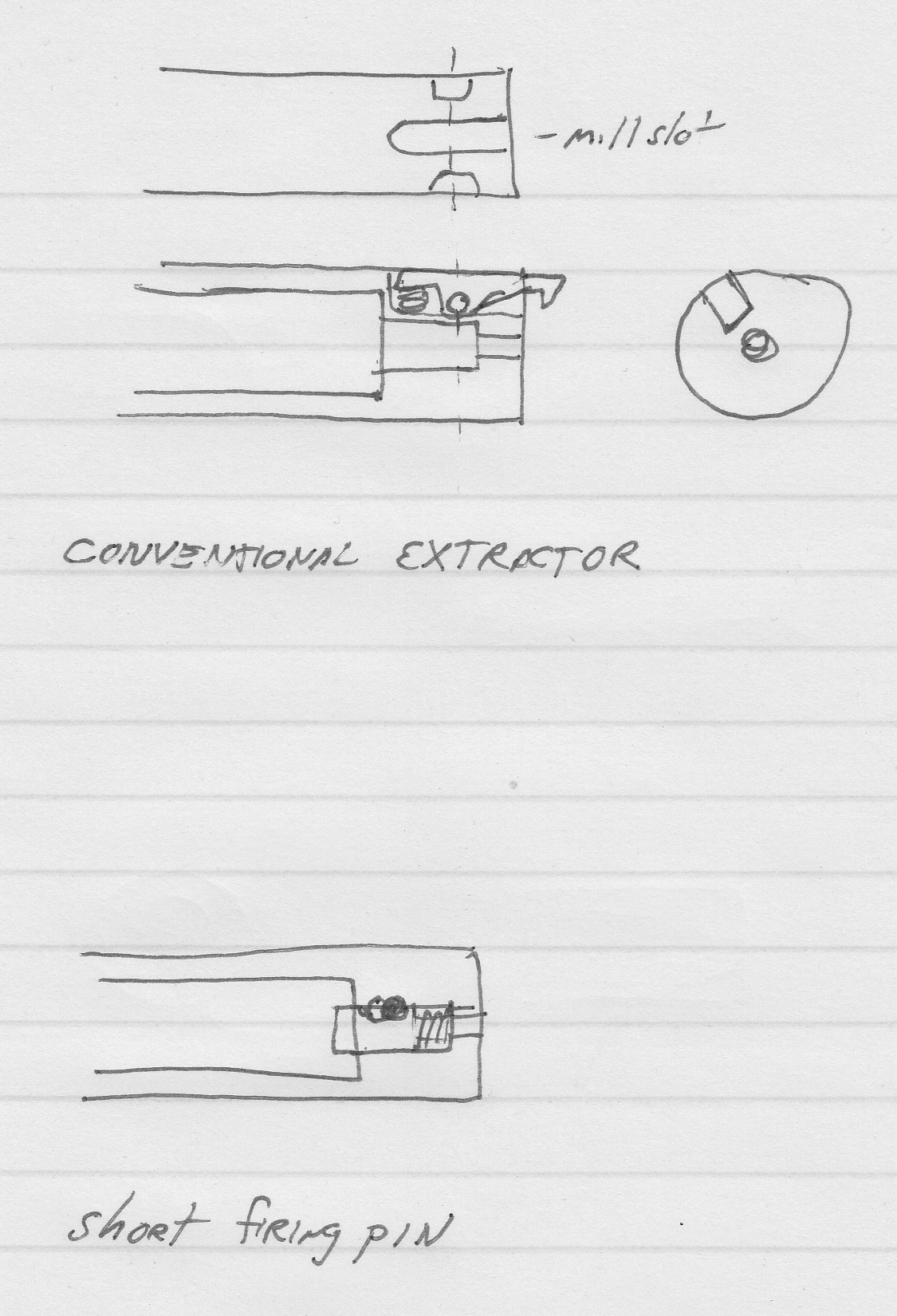
Finally, an ejector. Apparently Maxim's design didn't use one; lots of early blowback guns didn't. I thought about an AR or Savage style spring-loaded pin. There's room, but I wondered if it would push the cartridges off-center when going into battery. The Maxim bolt moves a lot further forward than an AR, with a stubby pistol cartridge.
I tried figuring various other designs, and finally came up with a hinged ejector behind the magazine, in the palm fillet area. It only needs a short slot in the bolt, and is held up by a hairpin spring. I like hairpin springs, just bend some music wire.
I started out trying to reverse-engineer Maxim's design from what little information was available, but as usual feature creep has set in... I've been thinking about a Ruger Mk1 style blowback pistol for a while, and this is heading in that general direction.

Quote from: TRX on November 01, 2012
Here's my take on a fire control group. The trigger hinges from the forward
end like the Maxim, and uses a "connector" pushrod that's spring-loaded
against the sear, which is pivoted in the bolt.
I thought I was hot stuff when I came up with that trigger group, but it looks like Browning beat me to it by 80 years or so, and it appears it had been used on some pistols before he used it on the prototype Hi-Powers.
That's the trouble when you're trying to come up with something new in firearms. Sooner or later, I always find out someone else did it first, in my grandpa's day.
Oh well, it's still a very nice layout, as far as I'm concerned.
TRX
October 04, 2013
Forgotten Weapons dug up more information on the Maxim:
http://www.forgottenweapons.com/maxim-silverman-1896-pistol/
He also has a link to the patent.